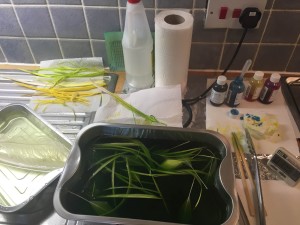Feather Dyeing, Cutting and making a Feather Mount. The thing with these classes are that in many cases I have the general idea of how to do these things, but it is the little tips and tricks of people who are experts that you pick up by taking a class or working with them in person that makes a huge difference. It is also great to learn different techniques. So learning how to dye and cut feathers from two different expert milliners is not a waste of time, in my opinion.

I took a great three evening feather cutting, dyeing and feather mounting class at Kensington and Chelsea College, here in London with milliner Ian Bennett. Ian gave out some lovely pages of notes that included his sketches, which were very helpful. I must admit to sketch envy. I would love to sketch well. You can get a glimpse of an Ian sketch in the corner of the image above from the results of my in-class dyeing.
Acid dyes are best for protein based fibers such as silk, wool and feathers. I experimented using some Jacquard dye I had from a previous silk dyeing project. The dyes were already in liquid form and I diluted them more, so my colours were not as bright as some, however I did like the softness of the muted colours.
I got a tripped up with the 24 hour time the night of my first class. I saw 18:30 on my calendar, and later remembered 8:30, rather than 6:30. I was embarrassingly late. I got the notes, but it just is not the same as being there. Ugh!
A few highlights
Sharp, long blade scissors, lightly pinch the spine, support the blade.


Nugget 1 – The ability to dye feathers (and other stuff) is one of the key elements to making unique one of a kind hat or head piece. Being unique helps enable you to charge couture prices for your creations.
Here is my dyeing station at home, aka the kitchen counter. I started with yellow, added a little blue, then added a lot of blue.
Do not boil the feathers, actively dry feathers, especially ostrich so the will return to being fluffy and not look bedraggled.
Nugget 2 – Feathers have personalities. This may seem obvious, but I grasped it on a different level after this class. You can trim them and change their appearance, but consider the “feeling” you want when making a feather mount. Some feathers are spiky like Biots and others have a “sharpness” like Turkey feathers. On the softer side, with a swaying movement are Coque feathers while a full ostrich feather offers a soft roundness. What about eye catching drama from Lady Amherst and Peacock feathers? Use them to create a tone and establish balance.

A feather mount is a collection of feathers that are combined onto a wire, so they can be placed on your hat as a single unit. Mine feather mount included goose, biot, hackle and a little bit of ostrich.
Nugget 3 – When making a hat, if you handle it too much it can look tired before you are even finished. By creating feather mounts you can conserve the amount of manipulation you need to do to the hat.
I have put my dyed feathers to use for my daughters school play. I am making 6 head pieces (aka fascinators) for the girls.



